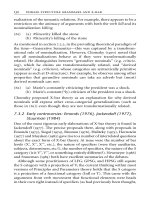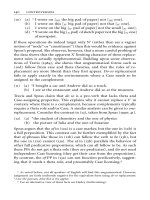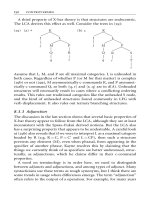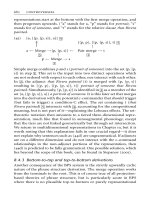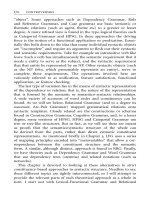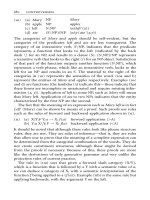Tài liệu Constituent Structure - Part 27 pptx
Bạn đang xem bản rút gọn của tài liệu. Xem và tải ngay bản đầy đủ của tài liệu tại đây (107.08 KB, 10 trang )
(h) (if) Mike had have played, then . . .
(If Mike would have played . . . )
(i) Mike had been beaten.
(j) Mike had been playing bridge.
(k) Mike must have played bridge.
(l) TP
Mike TЈ
T
must
vP
v
have
vP
v
been
vP
v
being
VP
V
beaten
The origins of the little v approach lie in the proper treatment of
double-object constructions like (33a). X-bar theory allows only one
complement position in the tree, so the two obligatory complement
NPs in (33a) are mysterious.
(33) (a) John gave Mary a book.
(b) John gave a book to Mary.
Further, Barss and Lasnik (1986) show that in goal–theme orders (33a),
goals c-command themes (34a, a’), and in theme–goal orders (33b),
themes c-command goals (33b, b’):
(34) (a) Mary showed John himself (in the mirror).
(a’) *Mary showed himself John (in the mirror).
(b) Mary showed John to himself.
(b’) ??Mary showed himself to John.
This means that the leftmost argument is higher in the tree than the one
on the right. Larson (1988) argues that a split-VP approach solves this
problem. There are two verbs give, one with two NPs and the other with
an NP and a PP. With the addition of the vP to host the agent, we have a
place for both the theme and the goal such that the Wrst c-commands
the second. Surface order is derived by movement of the V into the v.
240 controversies
() (a)
vP
(b) vP
NP
agent
vЈ NP
agent
vЈ
vVP v
VP
NP
goal
VЈ NP
theme
VЈ
VNP
theme
V
PP
goal
Having a split-VP structure then accounts for a wide variety of data,
while capturing both the locality of the VPISH and the distance of the
traditional VP. Other little v-like categories have been proposed in the
literature, including ApplP which, is tied to applicative constructions
(McGinnis 2001; Pylkka
¨
nen 2001, 2002). See also Harley and Noyer
(1998) for a discussion of the role of little v in nominalizations.
There is one further aspect of the split VP that remains to be
mentioned. Travis (forthcoming)26 argues using morphological evi-
dence from a variety of Austronesian languages and syntactic evidence
from languages with object shift that there is a functional category that
lies between the vP and VP which represents situation aspect (roughly,
aktionsart).
(36)[
vP
v[
AspP
Asp [
VP
...V...]]]
This projection also serves to case-mark objects. There is some seman-
tic motivation behind this projection: certain kinds of objects lead to
various situational aspect distinctions. For example, if you ate an
apple, the eating event ends when the apple is Wnished, by contrast, if
you just eat, the eating event has no clear end point. An object-
licensing category between vP and VP, in the guise of AgrO (object
agreement) is also found in Koizumi (1994, 1995). Carnie (1995) and
Carnie and Harley (1997) argue that you need both Aspect and AgrO to
account for the order of elements in Irish and Scots Gaelic non-Wnite
clauses; see also Noonan (1992, 1993, 1994) and Adger (1996). The claim
that Aspect is tied to the VP (or the domain of predication) is also
consistent with (under very diVerent assumptions) the views of Dik
(1989) and Role and Reference Grammar.
26 See also Ramchand (1993) and MacDonald (2006).
phrasal categories and cartography 241
11.4 The clausal layer
Much of the discussion in the following two sections concerns what is
known in the P&P framework as ‘‘functional categories’’. The literature
on functional categories is vast; so vast that I cannot hope to even
expose the tip of the iceberg. I give here some of the leading questions
and some of the matter that has the most consensus behind it, but the
reader should not consider these sections even remotely authoritative
or complete about the topic. In this section, we consider the nature of
the clause, that is, the structure traditionally labeled S in early gen-
erative grammar (and is still labeled as such in many approaches,
including LFG, GPSG, and HPSG).
There are three major classes of treatments for the clausal layer.
There are those views that have S as an unheaded category, whose
function is simply to license the predication between the subject and
the VP. This was the view of early transformational grammar and
survives to a lesser degree in some versions LFG but only in clauses
where there is no auxiliary to head an IP (InXectional Phrase).27 Far
more approaches adopt one of the other two approaches. In HPSG and
GPSG, the clause is a projection of the predicate of the clause, usually
the V. In GPSG this is because InXection is usually part of the verb, and
since the theory is meant to be ‘‘surface-true’’ it cannot express a more
abstract category like InX. In HPSG, the S category is simply the feature
structure that has all of its argument features fully resolved. A sign-
iWcant portion of the literature in the Principles and Parameters
tradition (both GB and MP) focuses on the third treatment: the clausal
layer is made up by one or more projections of functional categories,
which are headed by grammatical properties. Abney (1987) and Grim-
shaw (1992) suggest hybrids of the second and third approaches. They
have functional categories, but these are viewed as extended projec-
tions of the V. See Bury (2003) for a more up-to-date version of this
claim.
For the most part, we will focus on the functional category approach
and make reference to the others as necessary. I will largely assume that
the whole premise of functional categories (or something like them,
such as the operators in RRG) is well motivated; see Hudson (1996) for
a criticisms of this assumption and of the entire functional-projection
27 This is part of an larger programmatic restriction of ‘‘economy of expression’’, where
forms appear only in the c-structure of the sentence if they have overt expression as words.
See Falk (1983) for more discussion.
242 controversies
endeavor. I will also assume that functional categories and their relative
order to each other is universal. This too is controversial. For example,
Fukui (1995) claims that Japanese lacks functional categories, which
explains why wh-phrases in the language are in situ. Lebeaux (1996)
claims that functional categories are only present if they are required
for licensing. Ouhalla (1991, 1994) argues that SVO languages diVer
from VSO languages in precisely the order in which the TP and AgrSP
functional projections are found. He claims that VSO languages have
TP over AgrSP (which licenses nominative case) and SVO languages
have AgrSP dominating TP. These claims aside, a universal hierarchy
of functional categories—if it can be found—is to be preferred on
economy grounds.
Within transformational grammar and related approaches in the
1960s and 1970s (see for example Chomsky 1965), the S category was
unheaded, but often included an AUX category to host auxiliaries. This
category was thought to contain two elements, tense and agreement.
With the widespread adoption of X-bar theory for other categories, the
existence of an unheaded S category seemed suspicious. JackendoV
(1977) proposed that S was a verbal projection (V’’’ or a higher bar
level). This view was (and is) still widely adopted in the GPSG and
HPSG approaches to syntax.
()VЈЈЈ=S
NP VЈЈ
VЈ
V
Auxiliaries and temporal adverbs were in the speciWer of V’’.
Emonds (1978) proposed instead that there is a category InX (for
inXection) that hosts auxiliaries, and, in their absence, the features
associated with tense and inXection (37). Ken Hale suggested that
InX was the head of the S category in class lectures and an unpublished
paper in 1979. Stowell (1981) proposes that this category be assimilated
to the X-bar approach giving us InX,I’, and IP. Pesetsky (1982), Huang
(1982), and Falk (1983) all pursue and argue for this kind of approach.
When an auxiliary appeared, it occupied this head (38a). When the
inXection appeared on the verb, the InX category lowered to the V
(38b):
phrasal categories and cartography 243
() (a) IP (b) IP
NP IЈ NP IЈ
Infl
was
VP Infl
-ed
VP
VV
Koopman (1984) (see also Emonds 1978) argued that variation in the
position of the verb relative to various elements, such as negation or
adverbs between languages like French and English (and other lan-
guages including Vata) could be attributed to whether the moved to
InX (41a) or the InX lowered to the V (41b) (for the LFG equivalent to
this—head mobility—see Kroeger 1993):
(39) (a) I often eat apples. Adv V Obj
(b) Je mange souvent des pommes. V Adv Obj
I eat often of.the apples
‘‘I often eat apples.’’
(40) (a) I do not eat apples. not V object
(b) Je ne mange pas des pommes. V not object
I neg eat not of.the apples
‘‘I do not eat apples.’’
() (a)
TP
(b) TP
NP TЈ NP TЈ
Je T
[pres]
VP I T
[pres]
VP
VЈ
VЈ
AdvP
VЈ
AdvP VЈ
souvent V NP
often
VNP
mange
……
eat
With the addition of the VP internal subject hypothesis V ! InX
movement can also explain VSO order (see section 11.4). Positing an
InX head, even in contexts where there is no overt auxiliary, thus provides
a mechanism for explaining variation in word order across languages.
244 controversies




